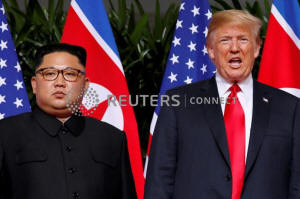|
Singapore to Hanoi: The bumpy diplomatic
road since Trump and Kim first met
 Send a link to a friend
Send a link to a friend
 [February 14, 2019]
SEOUL/WASHINGTON (Reuters) - It's
been the better part of a year since U.S. President Donald Trump and
North Korean leader Kim Jong Un stood face to face for the first time at
their unprecedented summit in Singapore. [February 14, 2019]
SEOUL/WASHINGTON (Reuters) - It's
been the better part of a year since U.S. President Donald Trump and
North Korean leader Kim Jong Un stood face to face for the first time at
their unprecedented summit in Singapore.
As the two leaders prepare to meet in Vietnam for a second summit, there
is a growing expectation that this time they need to make a more
specific agreement.
North Korea still has its nuclear weapons, and Washington has only
increased sanctions on Pyongyang so the stakes are high for both leaders
who have promised to overcome decades of tension and conflict between
the two countries.
Here is a breakdown of what Trump and Kim have agreed to, what has - and
hasn't - happened since they last shook hands, and what may be on the
negotiating table.
THE SINGAPORE AGREEMENT
The Singapore summit in June represented the first time a sitting
American president met with a North Korean leader, but the statement
that came out of the meeting was light on specifics, opting instead for
four general commitments:

* The two countries will establish "new relations" for peaceand
prosperity. * The United States and North Korea will work together
tobuild a "lasting and stable peace regime on the KoreanPeninsula". *
North Korea committed "to work toward completedenuclearization of the
Korean peninsula". * The two countries will recover and repatriate the
remainsof soldiers killed during the 1950-53 Korean War.
WHAT HAS HAPPENED SINCE SINGAPORE
Just ahead of the first summit, in May, North Korea destroyed some
tunnels and buildings at its Punggye-ri nuclear test site, observed by
international journalists but not expert inspectors.
Immediately following his meeting with Kim, Trump made a surprise
announcement that the United States would suspend military drills with
South Korea, which have often been criticized by North Korea as
rehearsal for war. Major exercises have been halted, while smaller ones
continued.
North Korea moved quickly to repatriate 55 boxes containing what were
believed to be the remains of American soldiers killed in the war.
In July, satellite images indicated North Korea had begun to dismantle
some facilities at its Sohae Satellite Launching Station, but later
reports by U.S. think tanks said no further dismantling had been
observed.
And North and South Korea moved forward with their own reconciliation,
holding three summits and taking steps to reduce military tensions along
their shared border by closing some guard posts, removing landmines, and
imposing a no-fly zone.
Other inter-Korea plans depend heavily on Washington's willingness to
support easing sanctions that block most economic engagement with North
Korea.
The past year was a see-saw of occasional public meetings - and canceled
visits - between American and North Korean officials.
U.S. Secretary of State Mike Pompeo traveled to Pyongyang multiple
times, first being condemned by North Korea over "gangster-like demands"
for the North's complete, verifiable, irreversible denuclearization,
then later earning Kim Jong Un's "satisfaction" with another meeting.
Trump, meanwhile, hosted senior North Korean officials at the White
House and declared that he and Kim "fell in love" after exchanging
letters.
In his New Year's speech, Kim said he was still open to meeting Trump
again, but warned of a potential "new path," which could indicate an
eventual return to weapons development, if he was not satisfied with the
negotiations.
A flurry of talks in early January led to Trump announcing the second
summit would happen in Vietnam at the end of February.
[to top of second column]
|

President Donald Trump and North Korean leader Kim Jong Un react at
the Capella Hotel on Sentosa island in Singapore June 12, 2018.
REUTERS/Jonathan Ernst/File Photo

WHAT HASN'T HAPPENED
Throughout all these talks, as well as other behind-the-scenes
negotiations, neither side announced major new steps toward
denuclearization, easing sanctions, or establishing a new "peace
regime" for the peninsula.
Statements carried by North Korean state media complained about
Washington's opposition to signing a peace declaration or easing
sanctions until North Korea takes more steps toward
denuclearization.
In the meantime, U.S. intelligence and defense officials say North
Korea has continued to develop its nuclear and missile arsenals,
despite a self-imposed moratorium on testing, and that the country
is unlikely to ever surrender all of its nuclear weapons.
After meeting with Kim in September, South Korean President Moon
Jae-in said the North is willing to "permanently dismantle" its
Yongbyon main nuclear complex and allow international inspectors
into some missile sites if the United States makes concessions of
its own.
But neither the American concessions nor the inspections have been
forthcoming so far.
WHAT MIGHT HAPPEN IN VIETNAM
American and North Korean officials have been tight-lipped about
what agreement might come from the second Trump-Kim summit, but
analysts say Washington needs to be open to taking interim steps for
any deal to be possible.
Stephen Biegun, the top U.S. envoy to North Korea, told South Korean
lawmakers that most of the recent discussions with Pyongyang had
revolved around summit logistics, and that more talks were needed to
address the substantive issues.

But Biegun said a "dozen" agenda items were discussed, one of the
lawmakers said, and North Korea has called for easing sanctions,
restarting some inter-Korean economic projects, opening a U.S.
liaison office in Pyongyang, and signing a declaration formally
ending the technical state of war from the 1950-53 conflict.
Other moves could include easing the ban on Americans traveling to
North Korea, or providing more bilateral aid.
To win some of those concessions from Washington, North Korea could
follow through on shutting its Yongbyon nuclear complex, as well as
abolish key missile facilities in the presence of foreign experts,
South Korean officials have said.
North Korea's state media said in December that Pyongyang's
commitment to the "denuclearization of the Korean peninsula" also
includes "completely eliminating the U.S. nuclear threat to Korea,"
but did not spell out specific steps Washington should take.
While some U.S. lawmakers and analysts have speculated Trump could
agreed to reduce the American military presence in South Korea,
officials in Seoul and Washington have said troop levels are not up
for negotiation.
(Reporting by Joyce Lee, Josh Smith, and Hyonhee Shin in SEOUL, and
David Brunnstrom in WASHINGTON.; Editing by Lincoln Feast.)
[© 2019 Thomson Reuters. All rights
reserved.]
Copyright 2019 Reuters. All rights reserved. This material may not be published,
broadcast, rewritten or redistributed.
Thompson Reuters is solely responsible for this content. |